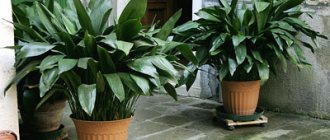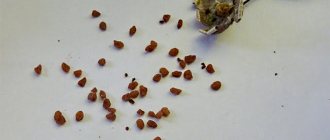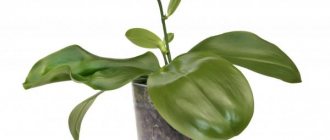In recent years, it has become fashionable to give not cut bouquets, but fresh flowers in a pot. As a birthday present, cyclamen appeared on my windowsill. Its delicate flowers looked like a flock of butterflies, wings half folded in a green meadow. I thoroughly enjoyed its appearance for almost 3 months until I noticed several dry leaves, and their number increased every day. I didn’t have much experience caring for this plant. I had to look for information in reference books, call friends and check the advice received empirically. The flower was saved, and I will be happy to tell you why my cyclamen began to dry out and what was needed to restore its health.
Why does indoor cyclamen dry out? © plantopedia
Prevention
It is best not to let the situation get to the point where the plant has to be helped. In addition to proper care measures that will prevent cyclamen from withering, you can do the following:
- planting and replanting it in soil that has been previously calcined, this serves as a good disease prevention;
- from time to time, water the soil in the pot with a very weak solution of potassium permanganate, which will prevent the spread of bacteria and fungi in it;
- When fertilizing cyclamen, do not overdo it with fertilizers containing nitrogen; in addition to inhibiting the flowering of the plant, they weaken its immunity;
- water the flower with soft, settled water at room temperature;
- avoid excess moisture in the soil and in the surrounding air, as well as extreme cold in the room; these factors contribute to the fact that cyclamen leaves can quickly wither.
Preventive measures or how to properly care?
Cyclamen is a capricious and demanding plant; its care must be of high quality and timely. What is important for a florist to know?
- We maintain the temperature . Suitable indicators are 12-15 degrees. It is prohibited to lower the temperature to +10 or increase above 20 degrees.
- Lighting control . The plant does not tolerate direct sunlight, but requires good lighting. The pot with cyclamen must be shaded.
- We water correctly . Water should not touch delicate foliage or tubers.
- We apply fertilizing only if the cyclamen fades quickly . It is allowed to add rotted compost (1:10 soil) or 1-2 tbsp to the soil. l. mineral salts. You can also feed young cyclamens.
IMPORTANT : Propagation by dividing the tuber is prohibited - this leads to rotting and death of the plant.
For prevention purposes, once a month you need to water the plant with a weak solution of Fitosporin, Fundozol, Gamair or Alirin B (see dosage on the package). These drugs will make cyclamen stronger, strengthen its protective properties and leave no chance for pests.
Growing from seeds
Cyclamen seeds
Cyclamen grown from seeds is more hardy than a ready-made specimen from the store. From birth he is adapted to the conditions of the home environment. You can sow cyclamen all year round, but the best period is February-March. At this time, daylight hours increase and seedlings do not need additional lighting.
Containers and loose soil for crops are prepared in advance. Cyclamen seeds are large, with a dense skin. They are first soaked for a day in water or a solution of growth stimulants. Then they are embedded in a damp substrate to a depth of 0.5 cm. The containers are covered with film to keep the soil moist. The crops are ventilated daily and checked for seedlings. They germinate unevenly, with the first seedlings appearing within 2-4 weeks. Favorable conditions are created for young plants: they select a well-lit place, control soil moisture, preventing drying out, and make sure that young nodules are completely covered with soil. The cover from the crops is removed when they get stronger and fully expand their leaves. During this period, within 1-2 months, the root system of cyclamen intensively develops. Through the walls of the transparent containers you can see how the roots are gradually filling the soil, which means it’s time to plant the plants.
Reproduction
Reproduction of cyclamen
Cyclamen is propagated by seeds, tuber division and division by daughter tubers.
The seed method is suitable for all types of indoor cyclamens.
Tuber division
Adult specimens are propagated in this way. After 7–8 years, many cyclamens lose their decorative properties and need rejuvenation. Divide the tuber in the dormant stage. It is removed from the ground and dried. It must be healthy and undamaged. Use a sharp knife to cut it into several pieces. Each division should have a bud and part of the roots. The sections are sprinkled with crushed charcoal and dried for 24 hours. Then the tubers are transplanted into separate pots with moist soil. The pots are placed in a shaded place and watered moderately to prevent rotting.
Division by daughter tubers
This propagation method is suitable for European cyclamen. Over time, small daughter nodules form around the mother tuber. They are easily separated from the main tuber when transplanted. They are planted in separate pots and cared for as young plants.
Awakening the plant
The end of the dormant period of cyclamen can be seen by the appearance of new green leaves on it. This is when you need to immediately arrange good diffused lighting and increase watering. For the first time after “waking up” it is not recommended to spray , i.e. increase humidity.
Gardeners also advise replanting cyclamen after it comes out of dormancy. To do this, you need to choose a pot in which the roots of the plant will fit freely, but at the same time the distance from them to the walls of the vessel does not exceed 1 - 1.5 cm.
The substrate for replanting can be purchased at a specialized store, or you can prepare it yourself by mixing leaf soil, humus, peat and sand in proportions 3:1:1:1. When planting, you need to take into account that 1/3 of the tuber should be above the ground .
Below is a visual video about how cyclamen awakens and what care it needs during this period:
Conditions for growing at home
Illumination
Cyclamen loves light, but not hot direct rays. On window sills on the south side it requires shading, so the plant will do better near southwestern, western or eastern windows with bright, diffused light. In summer, cyclamen is transferred to the balcony or garden terrace, to a shaded place.
Temperature
The culture does not tolerate high air temperatures. Optimal parameters for growth and development are 12-15°C. It reacts negatively to temperature increases above 18-20°C. At higher temperatures and dry air, you need to increase the humidity so that the plant does not die. The pots are placed in trays with wet expanded clay or pebbles, or the air around the plants is periodically sprayed. Cyclamen should not be placed near radiators or other heating devices.
The soil
A light nutrient substrate that allows water and air to pass through well is suitable for planting. The soil mixture is prepared from equal parts of leaf soil, humus, sand and peat. You can purchase ready-made soil specifically for cyclamen in the store. The soil acidity level for cyclamens should be 5.5–6.5pH.
Why leaves turn yellow - all sorts of reasons
Cyclamen leaves periodically turn yellow - this problem is sometimes encountered by plant owners. The cause of yellowing leaves is usually due to improper care and violation of maintenance conditions.
A possible cause of yellowed leaves of a home flower may be:
- Unsuitable temperature. Cyclamen is a cold-loving plant, so it does not tolerate high temperatures. It feels comfortable at temperatures ranging from +14C to +16C.
- Incorrect lighting. Insufficient lighting or direct sunlight on the flower can lead to yellowing of the leaves.
- Errors in watering and humidity levels. Excess or lack of moisture can immediately affect the plant. Cyclamen prefers moist air - too dry indoor air can cause yellowing leaves.
- Feeding errors. Lack or excessive feeding of the plant with fertilizers high in nitrogen can also cause yellowing of cyclamen leaves.
- Rest period. After abundant flowering, the plant prepares for rest and during this period the natural process of wilting begins: the leaves gradually turn yellow and dry out.
- Untimeliness and errors in transplantation. Cyclamen is replanted only before flowering. A prepared mixture of sand, leaf humus and turf soil is perfect for replanting. The rotten part of the tuber should be removed. On a note. The size of the pot in diameter should not exceed 15 cm.
- Pests. Infection of cyclamen with spider mites can also cause yellowing of plant leaves.
- Diseases. If watered incorrectly, water can cause a dangerous fungal disease in the root system - gray rot, which first causes yellowing of the above-ground part of the plant.
From the video you will learn why cyclamen leaves turn yellow in winter:
Causes
Usually caring for cyclamen is not difficult, but sometimes a flower in a pot withers and withers. The main reason is illiterate care of the pet, and if you do not react in time, the plant dies in a matter of days.
When you notice that a flower has a bad appearance and has begun to fade, the reasons may be the following:
- If the leaves wither after your pet has been moved into the apartment, this indicates that cyclamen is suffering from stress. Basically, this condition occurs due to sudden changes in temperature or humidity.
- In some cases, the flower withers due to a lack of mineral supplements. Cyclamen must be fertilized during the intensive period of growth; it is during this period of time that the plant needs feeding more than ever.
- Also, the plant may wither after purchase when the cyclamen enters a dormant state. Many inexperienced gardeners think that the plant is dead and is thrown away
Why does cyclamen not bloom, but withers? This happens due to non-compliance with the rules of care. For example, a flower dies from excessive moisture or high air temperature. If you do not adhere to proper care, the plant begins to wither.
The flower is very picky about the water with which it is watered. Experts recommend using soft and settled water at room temperature when watering. In addition, you should make sure that the air in the room is slightly humidified. The plant should be watered moderately; cyclamen does not like overwatering, otherwise it may negatively affect the general condition.
It should also be noted that the flower does not tolerate too salty soil. This happens if you over-apply mineral fertilizers. In very salty soil, the plant dies over time. Also, quite often the plant withers due to disease.
What kind of home care does the flower need at this time?
Some novice gardeners think that since cyclamen is dormant, there is no need to water it. How many gorgeous handsome men were destroyed thanks to such advice!
Cyclamen spends several months at rest and during this time not only the earthen ball will dry out greatly, but also the tuber itself. It will lose not only the nutrients accumulated during preparation for dormancy, but the tuber may dry out completely.
In the best case, the plant faces a long period of resuscitation; in the worst case, it cannot be saved and the cyclamen dies. During rest, it is better to reduce watering, but not stop completely. Watering should be very moderate so that the tuber does not rot (you can find out how to properly water cyclamen here).
When at rest, cyclamens are not fed, but to prevent rot, a little Fitosporin will not hurt. Add just a few drops, and the flower will not rot.
Helping you prepare for hibernation
When going to rest, the “sleeping flower” stops forming flower buds, but young leaves can still grow for some time. This is due to the fact that the tuber needs to store nutrients for the next waking period.
Important! It is very important not to allow the earthen ball to dry out completely!
The tuber actively stores “food” for future flowers and therefore cracks may appear on it. If you allow the soil to dry out, especially more than once, their appearance increases greatly.
Such cracks will not cause much harm to the cyclamen if you do not immediately fill them with plenty of water. Getting into the cracks, water contributes to the rotting of the tuber, and the plant will tolerate dormancy much worse.
It is possible to fight the decay of cracks. It is enough just to cover them with ash or crushed coal. After this treatment, the wounds will crust over within a few days.
Dying, yellowing leaves and drying flowers are carefully removed. This should be done by removing them along with the peduncles and leaf petioles, all the way to the surface of the tuber. Cyclamen rarely shed their leaves completely. Gradually reduce watering and move the plant to its place.
Is it necessary to force the plant into this state?
There is a false opinion that if, due to the time of year, it is time for the cyclamen to rest, but it does not want to and continues to bloom, it is necessary to force it to do so. Trimming leaves and twisting flower buds - you can't do anything better for your pet. Cyclamens that are forcibly retired get sick and may even die.
If the plant itself is not yet ready to retire, you cannot force it to go to sleep! Cyclamen should be helped and protected from direct sunlight. Place it in the shade for now, and the plant will gradually go to rest on its own.
An interesting fact is that young cyclamen may not “hibernate” at all. They continue to be “awake” and bloom all year round. Over time, their regime will return to normal.
Advice! If your handsome flower is still young and blooms all year round, don’t forget about feeding. Otherwise, your still “unsleeping” friend will become very exhausted, and you risk losing him.
After care
- It is necessary to place the pot with cyclamen in a slightly shaded place without direct sunlight. The room temperature should not exceed +20 degrees and not fall below +10.
- Two days after the procedure, when the top layer of soil has dried a couple of centimeters deep, water moderately.
- Spray with Epin-extra once a week until complete recovery.
- Fertilize once every 14 days with phosphorus-potassium fertilizer. The concentration of the fertilizer used should be two times less than indicated in the instructions for use. It is better to postpone the next feeding of cyclamen if it falls on a cloudy day.
- Do not spray the plant unless absolutely necessary.
Our experts have prepared for you other articles about the main types, signs and methods of treating them, and you will also learn about which ones are dangerous for the plant and how to deal with them.
Cyclamen does not tolerate excessive moisture.
Excessive watering causes the tuber to rot and can lead to irreversible consequences. If the flower is flooded, an emergency transplant is necessary to prevent the death of the plant. If the roots are rotten to a high degree, the flower cannot be saved. It is important to know how to properly water cyclamen so that the plant remains healthy and develops successfully.
If you find an error, please select a piece of text and press Ctrl+Enter
.
Cyclamen is very often found in our homes as an ornamental plant. This flower has a wide range of colors in its inflorescences, so it fits perfectly into the “home garden” organized on the windowsill. Some gardeners are faced with the fact that the plant withers. This article will tell you why cyclamen withers and how to deal with it.
As a rule, caring for cyclamen is simple, but sometimes a plant in a pot has a somewhat unsightly appearance. This could happen for many reasons and if action is not taken, the flower may die. The answer to the question “why does the plant die?” may have a wide variety of variations.
If you notice that cyclamen has dropped its leaves and withered, then the reasons for this condition may lie in the following:
- if such symptoms appeared after the pot was brought into the house, this means that the plant is under stress. This situation develops if the flowers were exposed to different growing conditions (for example, the wrong humidity or air temperature);
- exhaustion. The flower needs to be fed at certain periods (before budding and during the active growth stage). At this time, proper nutrition is needed through the application of fertilizers. If this is not done, the leaves will become limp;
- entering the resting stage. After the buds have bloomed, the cyclamen enters a dormant stage. The transition to this stage is characterized by the leaves withering. Many novice gardeners believe that the flowers die and throw them in the trash.
In addition, very often plants wither due to improper care. For example, cyclamen dies from excess moisture or temperature imbalance. Any deviation from standard care leads to the leaves drooping and withering.
Cyclamen are very demanding on the water regime, as well as the water with which they are watered. Here you need to use only soft and well-settled water. Moreover, it should be at room temperature. You also need to make sure that the air in the room is slightly humidified.
Separately, it is worth noting the fact that cyclamen does not tolerate an excess of salts in the soil. Excessive use of mineral fertilizers can lead to this condition. That is why, even if the care was correct at first glance, the flowers on the windowsill may look limp. But cyclamen does not always fade due to improper care. Very often, various diseases lead to this condition.
When does he go on vacation?
If the time for cyclamen hibernation approaches, and it continues to bloom, some try to send it to rest on their own, which is a grave mistake. Nature has its own laws for everything, and in this case they should not be violated.
To do this, they begin to get rid of still green leaves and buds by twisting them.
This absolutely cannot be done, because... this will completely disrupt the life cycle of the plant, especially if it was purchased and not obtained by propagation at home. Important! If a plant is purchased in a store, it can enter a dormant period at any time, because its life rhythm has not yet been established.
That is why you cannot force him into hibernation! All that remains is to wait until the cyclamen itself decides that it needs to gain new strength and create all the necessary conditions for this.
Why do problems occur with leaves and flowers?
The flower may look unhealthy because its leaves and inflorescences are withering. There are always reasons for this.
Leaves may wilt for the following reasons:
- if the flower is cramped in a real pot;
- if the bud has not been fertilized for a long time and there is a lack of nutrients in it;
- presence of pests;
- diseases.
ADVICE! When flowers fade at the same time as the leaves, you should pay attention to the soil in the pot and smell it. If you smell mold and acid, and the soil for the flower is covered with a greenish coating, then it is better to transplant the plant into another soil.
Features of growth
Cyclamen can be grown from seeds only with strict adherence to technology. The container with planting material must be covered with cellophane (pre-drill holes in it for air to enter) and placed in a warm place. The first shoots will appear in 25-30 days. Some varieties have a longer germination time - shoots of the Kiss and Apple species will appear only after 5-6 months.
The appearance of the first shoots is a sign that the plant needs to be moved to a cooler place. Next, a tuber grows from each bore, and a shoot with the first leaf is formed from it. The growth of young seedlings occurs imperceptibly, as they are actively growing the root system (the growth of greenery above the surface is temporarily suspended). Cyclamen should be replanted into a permanent pot after 2-3 leaves appear. If all the rules are followed, this occurs 90 days after the appearance of the first shoots.
Cyclamen diseases
If your flower pet has drooping leaves, and care is optimal and precise, then the reason for this condition lies in the disease. The main problem for cyclamen is various fungal infections. Why do pathogenic microorganisms appear on a flower? The reason again lies in improper care. If you over-moisten the soil, then with a high degree of probability pathogenic microorganisms will appear in it after some time.
Sick flowers look like this:
- the leaves wither. And very often on the one hand;
- they may turn yellow;
- leaves take on a deformed appearance;
- Mold or other symptoms of disease development may appear on the leaf blade.
What to do to prevent recurrence of problems?
In order to prevent disease or death of roses, it is necessary to follow certain preventive measures. First of all, do not neglect compliance with the rules of agricultural technology. If the plant is affected by mold or pests, proper care will help reduce damage to the flower.
In flower shops, plants in pots are fertilized with special fertilizers that maintain their beautiful marketable appearance. Also, in the room where flowers are displayed, acceptable air humidity is constantly maintained. Therefore, getting from the favorable conditions of a flower shop to less favorable apartment conditions, an indoor rose may become less attractive, fade or get sick (what should be the care of a rose after purchasing it in a store?).
It is recommended not to allow carelessness in care, even if the plant is in full health. Moreover, caring for an indoor rose is simple and does not require much time.
Pay regular attention to your plants and respond promptly to symptoms of illness.
By following these simple tips and recommendations, you can help your indoor roses and extend their life. With proper care and sensitivity, this plant can delight you with its magnificent flowers for a long time.
Cyclamen diseases
What to do if the flower dies? If you are optimally caring for your cyclamen and it has dropped its leaves, this condition may be caused by a disease. The main problem for your indoor beauty is various fungal infections. Typically, diseases almost always develop due to severe waterlogging of the soil.
What flowers look like when sick:
- the leaves take on an irregular shape - they become deformed;
- Quite often the leaves wither on one side;
- also in frequent cases the leaves turn yellow;
- Mold may develop on the leaves.
If a plant dies, it is often because the roots are rotting. You can notice this by the putrid smell that comes from the soil. The tuber may die if nothing is done.
The disease can be caused by insects, which also appear as a result of illiterate care. Why did the cyclamen wilt? This happens when a flower is attacked by various pests: cyclamen mites and aphids. In order to save the plant from insects, chemicals should be used.
If you take proper care of the flower, diseases and pests will not bother you, and the cyclamen will have a beautiful appearance.
Cyclamen is a perennial herbaceous plant of the Myrsinaceae or Primrose family. The flower's homeland is the Mediterranean and Asia Minor.
The approximate height of the plant is thirty centimeters. The tubers are flat-round in shape and have a common growth point. The diameter of the tuber is fifteen centimeters. Heart-shaped leaves. They grow at the roots on long brown petioles. The color of the leaves varies from light green to dark green with a silvery ornament.
The flower is bisexual, pointed in shape. It has a color ranging from light pink to purple. Includes five petals. The lower petal is slightly bent back. The fruit of cyclamen is a capsule with small seeds.
What to do if cyclamen is sick, how to revive a flower
If it was not possible to prevent the disease, the flower began to turn yellow and lose leaves, then treatment should be started immediately. The action plan is as follows :
- Carefully examine the above-ground part of the plant and remove all affected areas with a sharp blade , leaving only healthy green tissue. The cut sites are treated with any disinfectant.
When treating cyclamen, all affected parts are removed
- Now it’s the tuber’s turn. It is taken out of the ground and all questionable parts are also removed .
- The plant is left in a dry, ventilated area for several days to stop possible rotting processes;
- Then the flower is planted in new, pre-calcined soil . For several days it is placed in the shade and watered moderately. After a week, the plant can be returned to its usual place.
Disease is not a death sentence for a plant. This is just another, rather difficult, stage of his life. Whether the flower will be able to cope with it depends entirely on its owner. Thanks to perseverance, patience and responsibility, you can revive even a rather weakened plant , so that it will delight you with flowers of stunning beauty for a long time.
Is it possible to save?
Cyclamen can be saved only at an early stage of the development of a certain disease (when irreversible changes have not yet occurred to the plant). To provide quality assistance, you need to accurately determine the cause and quickly eliminate it.
TIP : The gardener may need a new pot and soil mixtures for replanting, peat and pebbles, and chemicals to eliminate pests. The main condition for proper recovery is providing quality care.
How to revive cyclamen after a period of dormancy
Dormant cyclamen care at home requires simple care - periodic watering and keeping it in a bright, cool place will be enough to preserve it, but gardeners are faced with the difficult task of how to wake up cyclamen. This should be done no earlier than 45 days after the bulb goes into hibernation, and to properly remove cyclamen from sleep, the following rules must be followed:
- Gradual increase in temperature - sudden warming can lead to drying out of the bulb;
- Increase watering - it is advisable to water it more generously at intervals of 3-4 days; you cannot spray the bulb, it may rot. You can irrigate the plant after the leaves appear, but it is important to ensure that drops of liquid do not fall into the center of the bulb;
- Organization of lighting (if the awakening is carried out in early spring) - the length of the day to revive the cyclamen should be 10-12 hours, but if it is summer or autumn, lighting will not be required.
It is not worth applying fertilizers to plants immediately after waking up; the optimal time to start fertilizing is the appearance of flower buds, and before this time it is permissible to apply half the dose of standard complex mixtures for indoor flowers. The beginning of flowering should be a signal for regular and complete maintenance of the plant with nutrient mixtures.
Cyclamen at home
Unfortunately, during the dormant period, cyclamen can suffer from disease or unfavorable living conditions. You can suspect something is wrong by such signs as the absence of leaves against the background of an increase in temperature and humidity, drying out of the bulb (it looks too small, wrinkles, and is easily pulled out of the soil). It is almost impossible to revive such specimens at home, especially if upon inspection of the bulb rot was discovered on the bottom, but it is worth a try - to do this, it is cleaned of damage with a sterile sharp knife, treated with charcoal or brilliant green and germinated in calcined, slightly damp sand. The method does not work if the rot has completely affected the bottom.











